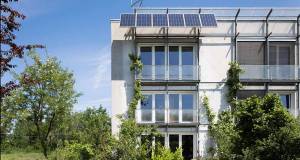- Local Authorities
- Posted
Planning for the Future

A marked lack of adequate central government action to promote sustainable house building in Ireland has been recently counteracted by planning authorities such as Fingal County Council taking action into their own hands, and setting standards geared to protect their constituents in an oil and gas scarce future. However, as sustainable building consultant Will Woodrow discovered from surveying planning authorities around the country, local government willingness is not always met with a full grasp of the issues needed to make sustainable housing happen.
At a time when an increasing amount of attention is being placed on achieving energy efficient housing, it stands to reason that the planning sector would be expected to have a central role in facilitating such a goal. Planning authorities, charged with overseeing the proper and sustainable planning of their jurisdiction, are uniquely placed to facilitate energy efficiency in the building sector both in a regulatory and an advisory capacity.
The National Climate Change Strategy not only identified the planning sector as having an important role in improving energy efficiency in the built environment, but also noted that local authorities have an important cross-sectoral role at local level and that they would be encouraged to adopt best international practice. It seems surprising, therefore, that there is little guidance from Government as to exactly what role planning authorities are expected to play or how they can achieve best practice.
A study carried out in late 2005 set out to ascertain the current and potential roles of planning authorities in facilitating energy efficient housing and domestic energy from renewable sources. This involved sending questionnaires out to 39 planning authorities (County, Borough and City Councils). Responses were received from 19, and these raised a number of issues relating to the roles that planning authorities saw themselves having in this area, the variation in current approaches, concerns that they had over specific issues, and the potential need for further information or guidance.
Particularly notable issues included: a clear feeling that energy (efficiency and renewable sources) was an important issue that planning authorities should have a central role in tackling; a considerable variation in the existence and content of facilitating policies for energy efficient housing and use of renewable energy sources; a mixed level of knowledge on energy issues including the Energy Performance of Buildings Directive (EPBD) and how it may affect their work, and a perceived need for guidance on it; potential conflicts in decision making between initiatives aimed at energy efficiency or renewable energy and other planning considerations; and a likely variation in the relevance of different issues and applicability of energy efficiency initiatives in different planning authority jurisdictions.
Planning Policies
All of the planning authorities that responded to the survey stated that they believed their authority should adopt a proactive policy on the promotion of energy efficiency of houses. However, less than 60% of them actually had a policy promoting energy efficiency of houses at all. The policies that did exist varied from a general intention to encourage sustainability in the built environment to very prescriptive policies to require consideration of specific energy efficiency features by planning consent applicants. The stronger policies contained such things as an explicit commitment to support or facilitate energy efficient design of houses and a commitment to improving the existing building stock (thus reflecting the requirements and general aims of the EPBD), a requirement for applicants to incorporate key energy efficiency principles into design (such as solar gain) and encouragement of developers to go beyond minimum Building Regulation requirements. The weaker ones, often encouraging issues such as ‘sustainable design’ in the built environment were sometimes not considered by planners to relate to energy efficiency, thereby enhancing their weakness.
In the same way, policies for the encouragement of renewable energy systems such as domestic wind turbines varied from a general support for renewable energy sources where they were in accordance with the “proper planning of the area” to very specific policies which referred to domestic turbines being those that produce less than 20 kilowatts or operate at wind speeds below 6m/s. Such policies should help planners make a clear distinction on what constitutes a domestic turbine, something that was clearly an issue with some of the survey respondents.
As well as all planning authorities believing that they should have facilitating policies for energy efficiency or renewable energy for domestic purposes, they also believed they should have policies promoting spatial planning of housing developments to achieve optimal solar gain and policies for the encouragement of multiple-dwelling renewable energy systems. This clearly suggests that the reason that some planning authorities do not have such policies is to do with something other than a conviction that it is outside their remit. The most likely reason seems to be a lack of awareness on the subject. It cannot be argued that the relevant development plans pre-dated any Government commitment on energy efficiency or renewable energy sources since the National Climate Change Strategy that gave some direction on such issues was published in November 2000 and the start date for development plans that had no energy efficiency or renewable energy policies ranged from 2002 to 2005. Whatever the reasons, it appears that, generally, there is a gap between where many planning authorities believe they should be in facilitating energy efficient houses and renewable energy sources through their policies, and where they currently are.
Furthermore, considering there is no specific requirement for planning authorities to be proactive about issues such as solar planning for housing developments or multiple dwelling renewable energy systems, it seems that planning authorities often believe that they should be pushing the agenda on this issue.
The Energy Performance of Buildings Directive
At a briefing I attended last year on the implementation programme for the Energy Performance of Buildings Directive, I asked the panel of SEI and Government officials what faith they had that the advisory approach (in other words, the requirement of energy certification) taken in the domestic sector was likely to result in a real value being placed on houses with better energy efficiency, bearing in mind the current strength of the housing market. The circumspect answer I got suggests to me that planning authorities need to be ready for all eventualities. They may need to be in a position where they can respond to an increase in applications for energy efficient houses if it happens and also be ready to push the agenda if the market response to certification does not occur.
This, itself raises the question of why planners do not seem, to date, to have been a target for information about the EPBD. Although there has been considerable interest in, and debate over, various aspects of implementation of the EPBD, this seems to have concentrated on the practical and technical aspects of implementation, such as identifying an appropriate methodology for assessment and rating of buildings. If, as is hoped, energy certification of houses will create a premium for energy efficient houses and stimulate energy efficient design of new houses and upgrade of existing houses, it is crucial that this can be facilitated through the planning system. It is arguable, in fact, that such facilitation should not only include an ability to allow improvement of energy performance of buildings, but also an active role in encouraging it, notably if the market does not respond as hoped.

Some of the 3000m2 of solar collectors on 18 terraced houses in Hamburg, revealing a progressive planning attitude
Survey answers relating to the EPBD showed that less than 80% of planning authorities were aware of the Directive, while over 65% believed it was likely to impact on their work (for instance through the need for new policies or design guides, or the need to promote energy efficiency to developers). It was also clear that a number of them have taken the initiative and introduced policies which, while not explicitly citing it, reflect the aims of the EPBD (such as promoting energy efficiency of new houses while committing to the improvement of energy performance of the existing housing stock).
Planning authorities are in a position where they have the potential to make a significant contribution to the technical implementation of the EPBD through the forward planning and planning consent processes. They also have the potential to further advance the general aim of the EPBD, which, under Article 1, is to “promote the improvement of the energy performance of buildings within the Community”.
The variable knowledge of and approach to the aim of the EPBD suggests that planning authorities should have been engaged earlier to discuss the roles they could play in implementation of the EPBD and to promote a concerted approach.
Potential conflicts between energy initiatives and other planning considerations
As well as through forward planning functions, planning authorities can have a considerable impact on energy efficiency and renewable energy in the domestic sector through the decisions they take in their development control functions. Part of the survey asked development control planners about how they may balance decisions on energy efficiency or renewable energy initiatives against other considerations. It was clear that, while issues such as innovative solar design would usually be acceptable (as long as some consideration is given to the character of the location), if orientation for solar gain meant large glazed areas facing roads or if placement within a plot to optimise solar gain meant breaking from buildings lines or minimum setback requirements then such initiatives were unlikely to be acceptable.
The differences in responses on potential conflicts with other planning issues in rural and urban contexts start to point to a need to place different emphasis on initiatives depending on the context. For example it became clear from responses on balancing issues such as orientation of a house or positioning within a plot to maximise solar gain against issues such as conventional orientation relative to a road or maintaining existing building lines, streetscape or urban form, that there was likely to be less flexibility in an urban environment.
Further exploration on this point can indicate a number of issues and options. Possibly the most obvious issue is that it suggests that different initiatives for both energy efficiency and use of renewable energy sources may be appropriate in different contexts with, for example, a greater emphasis on orientation and positioning for solar gain in rural and semi-rural environments and a greater emphasis on, say, avoiding thermal losses through better insulation or group heating schemes in urban situations.
Another issue that could be looked at, however, is whether a different attitude from development control planners might result in less concern over issues such as large glazed areas facing roads and better facilitate solar gain. There are examples across Europe where a relaxed attitude from planners, allowing alternative ‘street facing’ and ‘garden facing’ designs for southern aspects, have facilitated passive solar design in difficult urban situations.

Would planners concerns for buildings being consistent with the Irish vernacular prevent projects like this Dutch Solar Thermal housing estate?
Need for guidance
One of the overwhelming issues that came through in the survey was a perceived need, from both forward and development control planners, for guidance on the issues of energy efficiency, renewable energy and the Energy Performance of Buildings Directive. Some planners even stated that they believed that, in the future, energy is likely to be one of the single biggest issues they have to deal with.
It seems that guidance would be beneficial on a number of fronts. Firstly, it could help to ensure a uniformly high standard of energy efficiency and renewable energy policies in development plans (possibly through the use of best practice examples). Secondly, it could help inform planners of the energy benefits of certain initiatives when they are balancing decisions on them with the protection of amenities. Thirdly, it could put the planning authority in an informed position so that it could fulfil an advisory capacity at a pre-planning stage.
Many local authorities seem to favour encouragement of initiatives through pre-planning and the use of design guides is increasing (a measure which is supported by Government). Although a number of design guides cover issues such as solar orientation, they often do so from an ideal perspective (promoting, for example the purchase of rural plots on the south side of a road so that the main glazing, facing south, is away from the road). What would be useful is a design guide that looks at how to overcome these suboptimal conditions, for example using a combination of low screening and appropriate design to facilitate solar design in ‘road-facing’ southern aspects, or how to incorporate solar elements into traditional design, and so on. In addition, planning authorities could make information available to developers on technical aspects such as solar layout of developments which take account of the latitudes and housing densities appropriate to the authority. The value of advice and guidance came through in the survey, with those planning authorities that had close links with active Energy Agencies often seeming to be extremely well informed and, correspondingly, having better policies on both energy efficiency and renewable domestic energy initiatives.
New approaches
Recent developments in some Local Area Plans of adopting minimum planning requirements for energy efficiency and renewable energy have started to bring the energy issue to the fore in development planning. It seems to be accepted that such minimum requirements are in line with the Planning and Development Act, 2000, and it is certainly an approach that is being adopted by a number of Local Authorities.

A 1kw domestic wind turbine
It should not be assumed, however, that the response to such an approach lies purely with issues related to building control. It may well be that, if a developer is required to ensure a certain percentage of space and water heating needs are achieved through renewable energy sources, the most cost effective way is to try and reduce the space and water heating requirements as far as possible. This may often require an innovative approach to building design, placement and/or orientation that might require the attention of development control planners. In addition, many of the renewable energy initiatives themselves are likely to require planning permission. Again this points to the need for planners to be in an informed position.
A case in point is the Portmarnock Local Area Plan which has recently been amended to include collective average reductions of 60% in space and water heating requirement and associated CO2 emissions in both residential and non-residential developments, relative to baselines taken from part L of the Building Regulations (2002 and 2006, respectively). It also requires developments to achieve a 30% contribution to space and water heating needs from renewable sources. In pursuit of these targets, the local area plan cites a number of design and specification options that may assist. These options include “site layout and associated bio-climatic / passive solar design measures”. Assuming that, as is hoped, such an approach is adopted by other planning authorities, some consideration needs to be given to whether site layout and passive solar design measures can be optimised within the constraints of other planning considerations.
Responses in the survey carried out in 2005 showed that there were a number of areas where there were potential conflicts with initiatives aimed at energy efficiency and renewable energy. These included consideration of building lines, urban form, streetscape, adjoining developments, and concerns on overlooking and visual impacts. Many of the issues are not insurmountable through flexible and innovative approaches. Galway County Council, for example, states in recent Local Area Plans that “building lines may have to be relaxed to accommodate innovative design, create different urban form…” It seems reasonable to expect that, given a situation where relaxation of building lines policy could improve energy efficiency of a house, and imperative issues such as public safety are accounted for, such a course of action should be considered.
There is little doubt that planning authorities have a significant role to play in the move towards energy efficiency and use of renewable energy sources in the Irish domestic sector. However, 8 years on from the Sustainable Development Strategy, 5 years on from the National Climate Change Strategy and after the adoption into law of the EU Energy Performance of Buildings Directive, there is still no co-ordinated guidance from Government on the role that planning authorities are expected to play, except in the widest terms. This situation is reflected in the inconsistent and variable approaches by different planning authorities, despite the obvious acknowledgement by them that they have a significant role to play. There is a need for Government guidance on the role that planning authorities should be fulfilling, as well as technical guidance and sharing of best practice to ensure that policies and practices are achieving an optimal approach. There is also a need for individual planning authorities to examine what impact their physical and policy constraints have on their ability to facilitate various energy efficiency and renewable energy initiatives. These constraints should be examined to see where flexibility is feasible and can be of benefit and / or where there is a need for emphasis to be placed on more achievable energy efficiency or renewable energy measures.
With many planning authorities apparently willing to take the initiative on this issue, and some extremely forward thinking best practice examples emerging, it is crucial that all are given the tools and support necessary to ensure a concerted approach.
About the Author
Will Woodrow is an environmental and energy consultant based in Sligo, working and studying in the environmental sector for 20 years. As well as a masters degree in European Environmental Policy, Will has an MSc (Architecture) in Advanced Environmental and Energy Studies.
Will and Sligo-based architect Colin Bell (MSc (Architecture) Advanced Environmental and Energy Studies), are currently setting up a consultancy service for architects, developers and planners, providing advice on energy efficient and environmental building.
Photographs of Cloughjordan courtesy of Sally Starbuck, Gaia Ecotecture
- Planning
- authorities
- energy efficiency
- fingal
- sustainable building
- National Climate Change Strategy
- Energy Performance of Buildings
Related items
-
 Enniscorthy to host ‘make or break’ sustainable building summit
Enniscorthy to host ‘make or break’ sustainable building summit -
Energising Efficiency
-
 Major new grants for retrofit & insulation announced
Major new grants for retrofit & insulation announced -
 International passive house conference kicks off
International passive house conference kicks off -
 Grant launches online learning academy
Grant launches online learning academy -
 We can launch a new eco renaissance
We can launch a new eco renaissance -
 Towards greener homes — the role of green finance
Towards greener homes — the role of green finance -
 Viessmann launches new compact heat pump
Viessmann launches new compact heat pump -
 New issue of Passive House Plus free to read
New issue of Passive House Plus free to read -
 Saint Gobain launches online technical academy
Saint Gobain launches online technical academy -
 SEAI Energy Awards 2020 open for entries
SEAI Energy Awards 2020 open for entries -
 An Post to enter retrofit market
An Post to enter retrofit market

